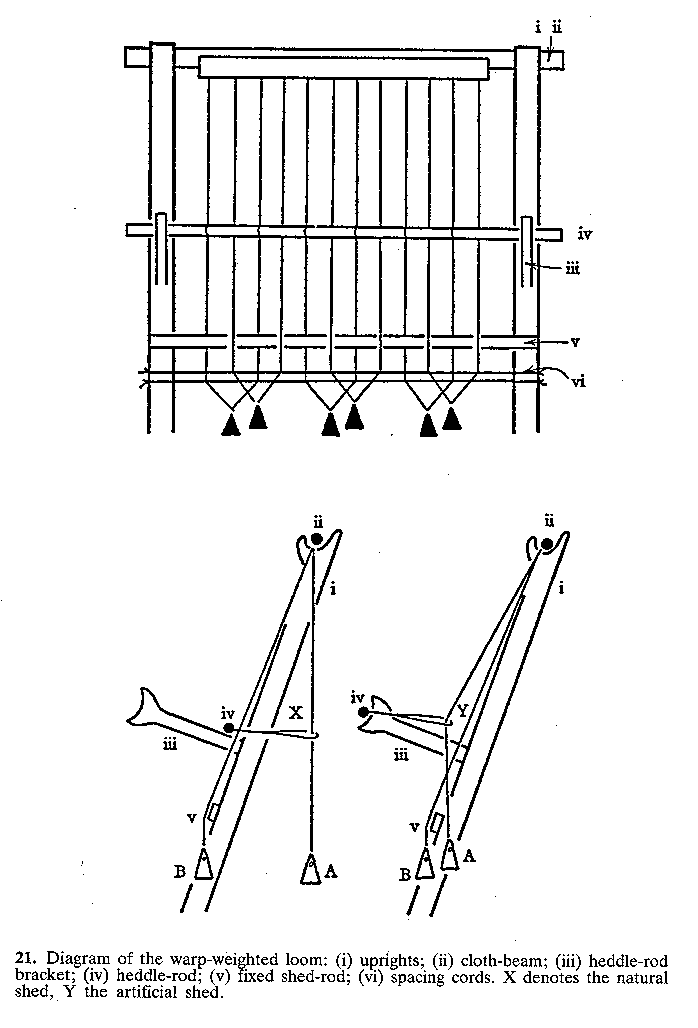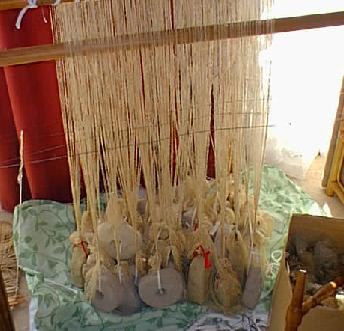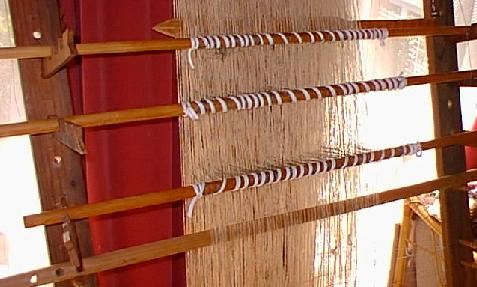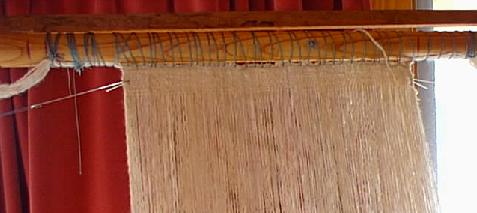
By Maggie Forest and Silvia Ravinet
Being an ongoing record of an attempt to weave a replicated fabric from Early Mediaeval northern Europe. This is the background for the project.
For the last few years, the idea of trying to recreate a fabric of a quality and type typical for the 'Dark Age' Scandinavian sphere had become the dream project for myself and Silvia. We are both interested in the technology of fabrics, spinning, weaving and dyeing, and both of us had been researching the history of it. The quality that our ancestors attained using simple tools and enormous skill was simply mind-boggling to us. In 1997, we decided we'd focus our efforts on learning enough to be able to replicate a real fabric, rather than samplers and trial pieces. Recognizing that this would be a very long-term project, we began looking at the options. Not trying to be too fancy, a simple tunic-type cloth, woven on the upright warp-weighted loom from homespun yarn was our goal. We could spin, we had a loom that Silvia had built. All we had to do was spin enough yarn and set it up...
It turned out to not be quite as simple as we thought.
The main stumbling block was the warp. Because of the way the warp-weighted loom works, the yarn has to be strong enough to withstand the weight of the loomweights. The fabrics we're trying to emulate used quite fine threads in both systems, and singles at that. Our quest for replica fabric turned into a quest for the warp.
We started off by researching what we should be making.
"The overwhelming majority of the Birka woolens were classifiable as worsted fabrics, that is, they were woven with yarn made from combed wool which produces a glossy surface without any sign of wooliness. The yarn is very fine and even, always Z-spun and the same in both warp and weft."
[...]
"The fine quality of these worsteds is best descdribed by the tightness of threads per centimetre in the warp and weft being respectively 28/14, 32/12, 38/14 and 46/14 in the 4-end twills and 50/17, 52/14, and 60/17 in the 3-end specimens. The relationship between wrap and weft can be proved by several still extant selvages - two sideway selvages and some starting borders. Examiniation of these small remains suggest that the warp-weighted loom was used..."
[...]
"...a weave which, because of the dense warp, seems bound to be the product of the warp-weighted loom. In this kind of loom the weft is packed or beaten within the shed with a sword beater, a method which allows the warp to be very dense. In the ordinary treadle loom, on the other hand, the weft is packed with a beater fitted with a reed. Clearly, a dense and fragile warp would have been worn out by the batting reed."
In North European textiles until AD1000, Lise Bender Jørgensen confirms that single-ply z/z is the most common textile found, but doesn't distinguish between wool and linen textiles.
Anne-Stine Ingstad writes about the Oseberg textiles (translated from Norwegian);
"[The warp]...was always tightly spun to be able to carry the warpweights which held them taut. In all the textiles mentioned here, these threads are Z-spun."
"[The weft]... could be either Z or S-spun, and it was quite often thicker and looser and of better wool than the warp."
So, based on the trends presented in these and other references, what we were trying to make was a fabric made from single-ply yarn, the warp worsted Z-ply, the weft either worsted or woolen and S- or Z-spun, but most likely a Z-spun worsted too. Even bearing in mind that the cloth would shrink if it was fulled after weaving, we wanted to achieve a rather fine thread, which was still strong enough to carry the warpweights. Spinning it tightly would help the strength, but clearly (as A-S Ingstad hints), the wool type would also affect the suitability of the warp.
The textiles found at the Mammen burial in Bjerringhøj, Denmark, were analyzed for wool type. The textiles there of particular interest to this project were the following;
| Textile | Weave | Yarn | Fleece | Dye | Twist | Diameter | Thread count/cm |
| C135a (i) Ground weave of embroidery | 2/1 twill | ZS | Hairy medium Gen. medium | none detected | 40°/45° | ½mm/½mm | 24/16-21/18 |
| C135a (iv) | 2/1 twill | ZS | Hairy Hairy | indigotin/ none | - | - | - |
| C135b gauze | tabby | ZZ | Shortwool | indigotin | 55°/55° | ¼mm/¼mm | 16/16 |
| C135d | tabby | ZZ | Medium | none detected | 40-50°/40-50° | -½mm | 20/18 |
Penelope Walton writes about the result;
"Five different fleece-types were identified. There are three examples of hairy types, comparable with the wols of the present-day mountain breeds of sheep, such as the Swaledale; three hairy medium, similar to the fleeces of modern whitefaced hill breeds, such as the Cheviot and Shetland; three generalised medium, like the woolly Soay (although the Soay is brown and the Mammen wools white); six medium, a type which is the fore-runner of the modern longwool, but perhaps best represented by the fleece of the Romney; and three shortwool, comparable with the wools of the modern Shropshire and Southdown breeds."
So now we had an idea of both the kind of cloth we wanted to produce, and the type of wool to use. We'd settle for the C135d material. A ZZ spun tabby, of medium wool (Romney type), and with a 20/18 set, spinning about a ½mm worsted thick thread (giving a little room for fulling.)
At first, we decided we'd experiment with the yarn, to determine just how much impact the fleece would have on the finished product. We decided to try the different types of wool we already had between us. We tried both worsted and woolen, a soft Romney, Drexel and Perendale (the latter two being Romney crosses). We were both comfortable with working on the drop spindle, but our initial attempts were spun on a spinning wheel for speed. We spun in the grease, but initally washed the yarn before warping. Each resulting yarn was warped up for samples on the warpweighted loom.
All the fleeces turned out a warp thread that broke as we were warping up the loom. We then tried warping in the grease, which was a little more encouraging. The best result we got was from Perendale, which is a rather long staple. Spun worsted and warped in the grease it held the weight of the loomweights reasonably well, but the thread was a good two millimetres thick, which was four times as thick as our goal of a medium quality yarn! Indeed, we decided, the wooltype mattered very much!
The first trial
We bought some different Romney wool (Micron 38-31. Staple length 145mm) which seemed like it matched the specifications listed for the Mammen find. The wool was very silky-soft, with a nice crimp to it. This time we used a drop spindle. Since both of us only had rather heavy drop spindles, we made a very light one from an african gum bead (50mm across) and a bamboo meat skewer. We also put a serious twist into the z-spun worsted yarn. It spun into a lovely fine thread, about 1/2 to 1/3 mm, that seemed stronger than anything we'd done before.
Fortunately, since this could have turned into a terribly difficult project otherwise, Silvia had already worked out how to build a warp-weighted loom, and tried out some of the warping systems extant for that type of loom.
A good summary of the technology of warp-weighted looms can be found in John Peter Wild's Textiles in Archaeology, from the Shire Archaeology booklets. Apart from a good summary of the kind of textile produced, it also shows the following diagram on the warpweighted loom and its function.

For Silvia, the interest in the warpweighted loom came from a fascination with anything to do with weaving, particularly the technical aspects of looms. She had became interested in historical looms early on and tried Navaho, Salish, Guatemalan backstraps...
The warpweighted loom was the European equivalent, but it was different from all other primitive looms. Additionally, you could add a reed comb to it (not that she has found that anyone actually did this, but...)
Building the loom was easy. Two 7' 2x4" beams, leaning against a wall. The first version had a back beam behind the uprights, and two protruding sticks to hold the shed-rod. On the second one she built she discarded the back-beam, using only the roller beam for stability; for the shed-rods she carved holes in the uprights and mounted 'crutches', three per side.

On this loom Silvia tried a simple two-shed setup. After that, she got brave and tried Hoffman's four-shed warping system. It was difficult, but it worked. Particularly the Icelandic four-shed worked really well.
There is an alternative warping system, in the article 'the warp-weighted loom, some technical considerations', by Haynes. There is no evidence that this is historically accurate, but it's similar to the setup on a horizontal loom and therefore easier if you're used to weaving on one. The four-shed setup worked very well with commercial yarn.
There were some potential issues that we needed to address. In Hoffman's system the sheds are not separately weighted, which means that when a shed is opened, some of the warp threads will have no tension on them. Haynes recognized this problem and weighted the sheds separately, and this seemed necessary. But space and movement could be a problem on a fine setup with many weights, particularly in a twill where there would be three or four rows of weights. We resolved to find out more about this.
We set up the loom with twenty warpthreads for a tabby, just to give it a go. This whole 'sample' was 1 cm wide!
Our first problem became obvious the moment we started setting up. The twist in the thread made it very difficult to work with the yarn. Second, even with ten threads to a weight, we were unsure if it would hold. After a little lateral thinking, our 400-gram loom weights were replaced by coffee mugs, weighing in at about 250g each.
The thread to use for the heddle was another concern. We settled on mercerised embroidery cotton for now; it was three times as thick as the warp threads and not ideal, but it was smooth and unlikely to do much damage to the wool. In future trials we'll probably use waxed linen thread.
We had a warp. We wove a couple of centimetres just to see if the warp was strong enough to handle being moved around as well as weighted. We found that the shed resisted opening, the wool being very 'sticky' and having to be manually opened with the beater for each in. This wasn't so much of a problem on a 1cm wide sample, but could become a problem on a wider piece. We tried sizing with linseed oil, which made it easier, and incidentally had the effect of making the weaving smoother but the hand harder/stiffer even after washing. Even so, the shed was still sticky, and the thought of dealing with this on a wide piece with a four-shed weave was somewhat unhappy. We needed to research the options.
The twist in the warp also caused us headaches, so we decided to let it all hang for a while to see if the tension of the weights would settle the twist somewhat. All in all, though, we declared our 5cm long sample a resounding success and celebrated with a cup of coffee while we planned the next step; a proper sample, 20cm wide.
The coffee cups would have to be replaced; a 20cm sample would require 400-odd warpthreads and even with ten threads to a weight, the average house is not equiped with 40 equally-weighing coffee mugs. We'd make a new set of proper weights from air-dried clay.

We also decided that we'd build a new loom - I had lusted after one for a while anyway, so we'd simply make the new loomweights for the new loom.
Last but certainly not least, we needed to spin up a lot of wool. We're planning to do a couple of 'spin-in' weekends, to make sure we get enough wool between us at an even thickness. Just for curiosity's sake, we also wanted to try to identify what it was about the Romney staples that made it successful as a warp, and to hunt around for other wools of similar type to try out. Gotland, Shetland and such types, little altered since the Viking Age, are considered 'exotic' in New Zealand, and finding wool could be difficult domestically. The very strict import laws means that it would be virtually impossible to import fleeces in the grease, and so we may have to settle for Romney.
...the quest goes on!
We struck lucky on the 'sticky shed' problem. An article written at Lejre Archaeological Research Centre addressed this problem in twills, by amending the systems of Hoffman and Haynes with a third, based on the find of 'notched' heddle rod brackets. Because each shed had two positions, their system meant that the sheds were kept open even when not used, and thus the problem with 'stickyness' would be lessened.

We also started leaning towards 135a, the 2/1 twill fabric from Mammen as our research project. The weave would be more forgiving than a tabbby, but it would mean having to re-visit our choice of wools. However, a New Zealand source for Gotland Fleeces appeared, and that might enable us to accurately do the twill; the samples of the fleeces would definitely qualify as 'hairy medium'.
The Gotland wool arrived, and we were very optimistic; it seemed to spin strongly, and it was a lovely soft wool. Sadly, however, the warp threads did not hold up to weighting and broke far too often for the Gotland wool to be an option.
After a long and disheartened hiatus, Silvia decided that warp be damned, she needed the experience of weaving enough cloth for a garment on the warp-weighted loom. Using generic wool (the owner described the animal as a 'sheep'), plied with cotton for strength, she warped up the loom to weave a 2/2 twill for a kirtle.

Silvia:
The material on the loom in the pictures above was warped quite close. The loom was set up with four separate warp systems and with a starting border. As you see in the photos the sides of the weaving were kept even with metal hooks that fastened to the sides of the fabric as I wove. The hooks were kept taut by wooden clothes pegs put into holes drilled into the sides of the loom.
I got enough woven for a couple of sleeves and gussets before the Romney Marsh which I had reinforced with sewing thread, started to stick together. I used boiled linseed, which produces a very slimy substance which can be brushed onto the warp. In this case it worked for a while, but in the long run it got too sticky so I cut the project short. I now have sleeves and gores for a non-existent tunic.
After I finished with this project I used commercial wool to start a lozenge twill. I tried the pattern in Martha Hoffman's book for this. I don't know if it was just me or if other people would have the same problem, but I found it very difficult and made errors in the knitting of the heddles.
"I ended up opting for the four-weight system again. I just find it so much easier to arrange the heddling for the pattern and so much easier to weave, whether using hand spun or commercial wool. But my feeling is that Hoffman's two row weight system was used at least until the introduction of the treadle loom around the 1000's or so."
There are advantages with the two-weight system.
· It is easier to deal with just two rows when weaving on single ply, because of the way single ply wants to wrap around itself even when it is well weighted and stretched before weaving.
· It's easier to do the chained spacing cord with just two rows.
· Another advantage with the two row system is that when knitting the heddles it is faster and you use less string because you are picking up two threads at a time. For example, you pick up 1+2, 2+3, 3+4, 4+1 as opposed to 1,2,3,4.
· You only lift one heddle at a time.
· It is easier to use longer warps, especially single ply, because of the two rows.
The disadvantages I find are
· There are only two good sheds. 1+2 and 3+4. Sheds 2+3 and 4+1 are slack. That goes against any weaver's notion of a well-warped loom. But on other pieces where I have tried this with a 2/2 twill, you just don't beat in the slack sheds, you wait until you get to the good ones.
The four row system has the advantage of it being easier to arrange the heddling, and having easier sheds, but it is somewhat clumsier to chain four rows and keeping them separate.
Martha Hoffman mentions that it would have been difficult to do a 2/1 twill on a warp-weighted loom. I have found to the contrary; it's very easy. The lozenge type twill was really more of a rose path pattern but looked really nice. So I might try a 2/1 twill for the tunic body to match the orphaned sleeves and gussets. Watch this space!
Inspired by the sight of a warped-up loom, we started looking around again for the correct warp. We came in contact with Föreningen Gutefåret, the Association for the Preservation of the Gute Sheep. This was the sheep we had believed we had found with the Gotland fleece! Turns out, the Gotland sheep was bred for its fur, and consequently the wool is not suitable for what we wanted. The Gute sheep is in fact the original sheep from Gotland, and unchanged pretty much from the Bronze Age. Ragnar Edberg, the secretary of the Association, provided us with samples from his own flock, and we do believe we have it! His help and explanations have been invaluable to us in this project.
We also contacted MAF and were given the information on what was required to import wool. Turns out that we can in fact import up to 20 kg of wool, given certain conditions.
As an aside, the wool from the Gute sheep is absolutely a delight to work with. It is almost completely straight, very hairy, yet it holds together very firmly. It's like butter to spin - we found we didn't even have to comb it, just teasing the ends apart and pulling into a natural 'sliver' was sufficient to spin a strong worsted thread. Quite aside from this particular project, the wool seems like it would be absolutely lovely as a knitting wool, for example, if spun softly. If you are interested in this wool, see the Gute sheep website for more information.
Watch this space for more information as it happens!
Says Silvia: "On the subject of wool types for single ply warps: if you cant get good Icelandic wool suitable for single ply or wool from any other primitive sheep, I have found that the raw fleece from a Border or English Leicester or from the Lincoln sheep is very good. It is very strong and smooth."
References in no particular order;
"What sheep is that" - tourist leaflet. Contains specifications of the types of wool yielded by typical New Zealand breeds.
Anne Stine Ingstad "Tekstilerne i Oseberg skipet" from "Oseberg dronningens grav"; Ingstad, Christensen, Myhre; publishers Shibsted.
Articles about the Mammen find from "Mammen, grav, kunst og samfund i Vikingetid"; Ed. Mette Iversen; publishers Jysk Arkaeologisk selskabs skrifter/Aarhus Universitetsforlag
Birka references in "The textile finds from Birka" by Agnes Geijer, in "Cloth and Clothing in Medieval Europe", Pasold studies in textile history:2; ed. Harte & Ponting.
By Lise Bender Jørgensen;
"North European Textiles until AD 1000"
"North European textile production and trade in the 1st
Millenium AD - A research project"
Margrethe Hald, "Early Danish Textiles"
John Peter Wild, "Textiles in Archaeology", part of the Shire Archaeology series.
Kerstin Gustafson, "Vadmal - tradition och fornyelse", published by Miljo-Pedagogik
Martha Hoffman, "The Warpweighted Loom"
A. E. Haynes, "Twill weaving on the warp weighted loom: Some technical considerations."
Anne Batzer and Lis Dokkedal, "The Warp Weighted Loom: Some new experimental notes", Historisk-Arkaeologisk Førsøgscenter, Lejre
http://www.dernehealde.org/loom/l_loompics.html
http://www.icelandicwool.com/vefstadur/vefstadur.html
http://www.cs.vassar.edu/~capriest/wwloom.html
http://www.smith.edu/hsc/museum/ancient_inventions/hsc00b.htm
http://www.inform.umd.edu/Caprina/Images/pages/021/044.htm